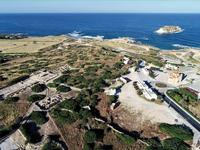Press Releases

22-11-2024 10:35
The Department of Antiquities announces the completion of the 18th season of the Pyla-Koutsopetria Archaeological Project
The Department of Antiquities, Deputy Ministry of Culture, announces the completion of the 18th season of the Pyla-Koutsopetria Archaeological Project (PKAP) under the direction of Dr Brandon R. Olson of Metropolitan State University of Denver, Dr Melanie Godsey of Trinity University, and Dr Tom Landvatter of Reed College. The team would like to acknowledge the support of Dr Giorgos Georgiou, Director of the Department of Antiquities, the staff of the Archaeological Museum of Larnaka District, CAARI, and the Dhekelia Base Civilian Estates Officer and their staff. The project was funded by Reed College, Metropolitan State University of Denver, and private donors.
PKAP’s excavations at the site of Pyla-Vigla over the past several years have revealed the presence of an early-Hellenistic fortified site located on a steep plateau overlooking Larnaka Bay. The military nature of the site is demonstrated by the discovery of an extensive fortification system, projectile points, lead sling bullets, and evidence of weapons production. The architectural, ceramic, and numismatic evidence discovered so far date the occupation of Vigla to the late 4th and early 3rd centuries BC. PKAP’s results through 2012 can be found in Pyla-Koutsopetria I: Archaeological Survey of an Ancient Coastal Town, published by the American Society of Overseas Research (ASOR) in 2014 and Pyla-Koutsopetria II: Archaeological Survey of an Ancient Coastal Town, a forthcoming volume (2025) also to be published by ASOR. Results of the 2018, 2019, 2022, and 2023 seasons can be found in recent articles in the Journal of Hellenistic Pottery and Material Culture. A synthetic treatment of PKAP’s work at Vigla through 2019 can be found in Études et Travaux XXXIV, published in 2021.
Building on the 2023 season, PKAP’s 2024 fieldwork was focused on further understanding of the domestic areas of site in the center of the plateau, as well as clarifying the nature of the site’s topography through a microtopography survey. PKAP continued excavation in two 5x5m trenches that remained open from previous seasons; opened two additional 5x5m trenches in the same area; and worked to remove three baulks to better understand the architectural layout of the building complex. The excavation units in the domestic area continued to reveal several rooms with multiple architectural phases and distinct assemblages. Over the course of this season several important in situ floor assemblages were revealed. Beneath one of these contexts, a molded female figurine dating to the 5th century BC was discovered (fig. 1) – representing the earliest extant evidence antedating the construction of the fort. Additional finds included numerous complete ceramic vessels, inscribed lead sling bullets, bronze coins, projectile points, iron daggers, lead weights, and beads.
Future work planned for Vigla will continue to focus on the interior architecture and the nature of activity within the residential/industrial areas, as well as clarify aspects of the fortification system.
(EK)
Relevant Press Releases


22-11-2024 11:25
The “Royal Chapel” of Agia Aikaterini at Pyrga closed for the public


04-11-2024 13:18
Announcement by the Cyprus Academy of Sciences, Letters, and Arts



